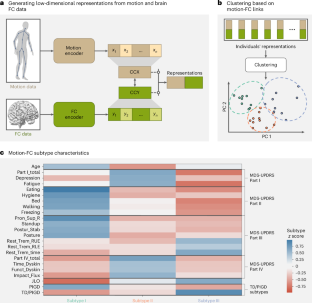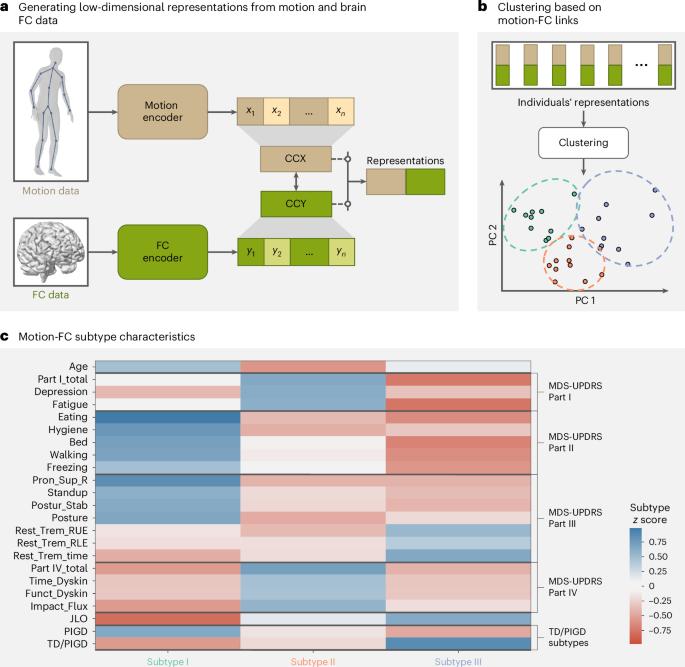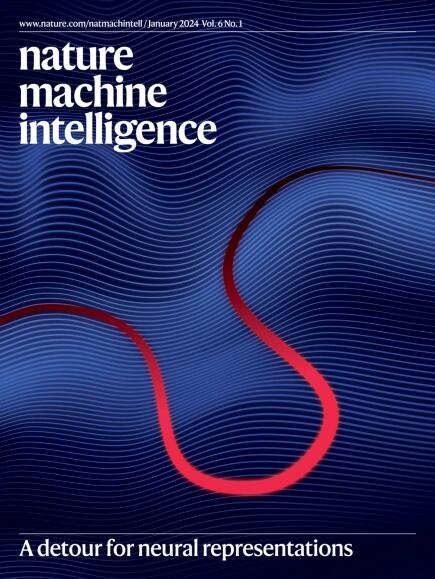数据驱动发现神经退行性疾病中与运动相关的异质性
IF 18.8
1区 计算机科学
Q1 COMPUTER SCIENCE, ARTIFICIAL INTELLIGENCE
引用次数: 0
摘要
神经退行性疾病表现出不同的运动和认知体征和症状,具有高度异质性。解析这些异质性可能有助于更好地了解潜在的疾病机制;然而,目前的方法依赖于临床评估和任意选择的行为测试。在这里,我们提出了一种数据驱动的亚型分析方法,该方法使用视频捕捉的人体运动和静息状态功能磁共振成像的大脑功能连接。我们将这一框架应用于处于帕金森病不同阶段的人群。这一过程通过将数据投射到一个典型相关空间,将数据映射到低维测量值,从而确定了三种帕金森病亚型:亚型 I 的特征是运动困难和视觉空间能力差;亚型 II 表现出日常生活活动中的非运动部分困难和运动并发症(运动障碍和运动波动);亚型 III 的特征是震颤症状占主导地位。通过将我们的方法与现有的、广泛使用的方法进行比较,我们进行了收敛有效性分析。比较后得出的亚型在我们为划分亚型而创建的运动-大脑表征空间中充分聚类。与其他形式的亚型划分方法不同,我们的数据驱动方法通过数字视频客观地捕捉到了可预测运动障碍和亚型成员的生物标志物。本文章由计算机程序翻译,如有差异,请以英文原文为准。


Data-driven discovery of movement-linked heterogeneity in neurodegenerative diseases
Neurodegenerative diseases manifest different motor and cognitive signs and symptoms that are highly heterogeneous. Parsing these heterogeneities may lead to an improved understanding of underlying disease mechanisms; however, current methods are dependent on clinical assessments and an arbitrary choice of behavioural tests. Here we present a data-driven subtyping approach using video-captured human motion and brain functional connectivity from resting-state functional magnetic resonance imaging. We applied our framework to a cohort of individuals at different stages of Parkinson’s disease. The process mapped the data to low-dimensional measures by projecting them onto a canonical correlation space that identified three Parkinson’s disease subtypes: subtype I was characterized by motor difficulties and poor visuospatial abilities; subtype II exhibited difficulties in non-motor components of activities of daily living and motor complications (dyskinesias and motor fluctuations) and subtype III was characterized by predominant tremor symptoms. We conducted a convergent validity analysis by comparing our approach to existing and widely used approaches. The compared approaches yielded subtypes that were adequately well-clustered in the motion-brain representation space we created to delineate subtypes. Our data-driven approach, contrary to other forms of subtyping, derived biomarkers predictive of motion impairment and subtype memberships that were captured objectively by digital videos. Diagnostic strategies for neurodegenerative diseases involve various data types, related to motor and cognitive signals. Endo et al. describe a data-driven subtyping approach for Parkinson’s disease, combining motion data (from videos) and brain functional connectivity data. The method reveals clinically relevant subtypes and digital biomarkers, uncovering movement-linked heterogeneities of Parkinson’s disease.
求助全文
通过发布文献求助,成功后即可免费获取论文全文。
去求助
来源期刊

Nature Machine Intelligence
Multiple-
CiteScore
36.90
自引率
2.10%
发文量
127
期刊介绍:
Nature Machine Intelligence is a distinguished publication that presents original research and reviews on various topics in machine learning, robotics, and AI. Our focus extends beyond these fields, exploring their profound impact on other scientific disciplines, as well as societal and industrial aspects. We recognize limitless possibilities wherein machine intelligence can augment human capabilities and knowledge in domains like scientific exploration, healthcare, medical diagnostics, and the creation of safe and sustainable cities, transportation, and agriculture. Simultaneously, we acknowledge the emergence of ethical, social, and legal concerns due to the rapid pace of advancements.
To foster interdisciplinary discussions on these far-reaching implications, Nature Machine Intelligence serves as a platform for dialogue facilitated through Comments, News Features, News & Views articles, and Correspondence. Our goal is to encourage a comprehensive examination of these subjects.
Similar to all Nature-branded journals, Nature Machine Intelligence operates under the guidance of a team of skilled editors. We adhere to a fair and rigorous peer-review process, ensuring high standards of copy-editing and production, swift publication, and editorial independence.
 求助内容:
求助内容: 应助结果提醒方式:
应助结果提醒方式:


